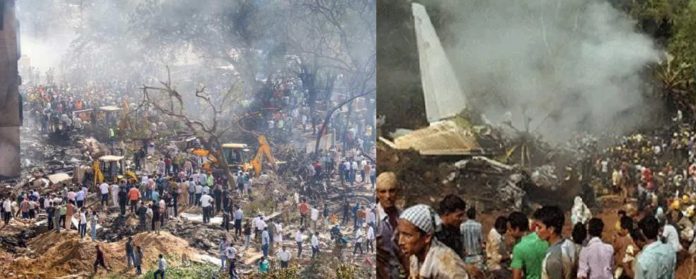– M Rafi Ahmed
A black day for India as Ahmedabad witnessed one of the deadliest flight crashes wherein around 241 on board, including passengers and cabin crew, were feared dead. The Dreamliner Boeing aircraft which took off from Sardar Vallabhai Patel International Airport at 1.47pm to London crashed in the Meghnani region. However, like a medical miracle, one passenger survived and is now under treatment at a hospital.
Turning the pages of history, this scribe zeroed in on the first air crash in Ahmedabad on October 19, 1988 wherein Indian Airlines Flight 113, a Boeing 737-200, while approaching Ahmedabad Airport from Mumbai claimed 133 of the 135 people onboard, including all six crew members. The aircraft struck trees and a high-tension pylon before crashing 2.5 km from the runway in poor visibility.
Investigations found the primary cause was pilot error – descending below safe altitude without sighting the runway – compounded by inadequate visibility reports from airport authorities. Only two passengers survived initially, but both later succumbed to their injuries, making it one of India’s deadliest aviation disasters. Both the mishaps were linked to Runway 23 as death came calling to the passengers on board in the ill-fated flights.
Sadly, the Air India plane crash yesterday was the second such major tragedy in the city since 1988. The Indian Airlines Flight 113 carried 129 passengers – including 124 adults and five children – and six crew members comprising the captain, co-pilot, and four cabin crew. It remains the deadliest accident in Indian Airlines’ history. Originally scheduled to depart Mumbai at 05:45 IST, it was delayed by 20 minutes due to a no-show passenger, finally taking off at 06:05. However, in the moments leading to the crash, the flight crew neither sought permission or clearance for landing nor provided standard call-outs after descending below 1,000 feet (300 metres).
Findings of a probe into the 1988 incident attributed it to the pilots’ error linked to descending below the minimum altitude of 500 feet or 150 metre. There were reports that the two pilots had problems sighting the runway and lost track of their altitude in their efforts to approach the airport that lacked approach lights or visual approach slope indicator (VASI).
Meanwhile, a court of inquiry into the 1988 crash had concluded that the aircraft hit trees and a high-tension electricity tower close to Chiloda Kotarpur village. The plane crash in 1988 resulted in the death of Professor Labdhi Bhandari from Indian Institute of Management, Ahmedabad. All the six crew members, including two pilots, and 129 passengers, including 5 children, perished in the Ahmedabad crash in 1988.
And the crash was the deadliest crash in the history of Indian Airlines since it was the fifth-deadliest civil aviation accident in India after the 1996 Charkhi Dadri mid-air collision, Air India Flight 171 (2025), Air India Flight 855 (1978), and Air India Express Flight 812 (2010). The aircraft was a Boeing 737-200, registered VT-EAH, delivered to Indian Airlines in December 1970, and had accumulated 42,831 hours and 47,647 landings. The flight crew consisted of captain O.M. Dallaya and first officer Deepak Nagpal.
In a suit filed by victims’ kin, an Ahmedabad court had said that the degree of negligence on the part of the pilot-in-command and the co-pilot of the Indian Airlines was so high that the same amounted to “recklessness” on their part as contemplated by the Carriage by Air Act, 1972. According to a report, an Ahmedabad textile businessman Ashok Agarwal, 61, had survived the plane crash in which his wife Abha, then 22, their 11-month-old daughter Ruhi, and 125 other persons were killed.
They were travelling in a Mumbai-Ahmedabad flight. The other person who survived the crash was Vinod Rewa Shankar Tripathi. Ashok Agarwal after years of battling trauma and memory loss, he led a reclusive life. On March 15, 2020, he was found dead in his Ahmedabad home in Prahladnagar area. Police report said that the death was due to cardiac arrest.
In 1989, Indian Airlines had initially offered to pay Rs 2,00,000 as full and final settlement to the relatives of each of the victims, the maximum amount allowed under Rules 17 and 22 of the Second Schedule to the Carriage by Air Act 1972. To receive a higher payout, the plaintiffs would have to prove under Rule 25 of said schedule that the damage resulted from an act or omission of the airline done recklessly and with knowledge that damage would probably result, so as to render the limit of liability (Rs 2,00,000) inapplicable.
The compensation award was successfully challenged in the Ahmedabad City Civil court on 14 October 2009 and higher amounts were awarded by the court on a case-by-case basis, including factors such as age of the deceased, income, occupation, future prospects and life expectancy. Later, a high court bench comprising Justice M S Shah and H N Devani passed the order and directed Indian Airlines and the Airport Authority of India (AAI) to pay the compensation to the petitioners by 31 December 2009. Indian Airlines was to pay 70 per cent of the compensation and AAI the remaining 30 per cent. The compensation amount was to be paid along with an interest of nine per cent per annum calculated from 1989 when the petitioners had approached the lower court.
[The author is former Indian Express and Deccan Chronicle chief]




